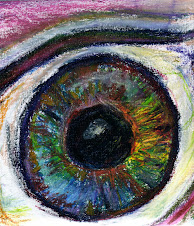Efficient readers move their eyes quickly across a page of text decoding words and processing meaning. The most efficient readers even scan and recognize familiar words by their shapes. It takes more than good phonetic skills and a good visual memory to read fluently though. People who have deficits of their saccadic eye movement skills can't usually do it. Because their eye muscles are not developed well enough for them to control where to point their eyes, they may not be able to maintain a fixation long enough to process the word or its meaning. When they lose the fixation, they also lose their place in the text.
Fortunately, saccadic eye movement skills are fairly straight forward to improve. Starting with monocular activities that exercise each eye by itself, the eye muscles get strengthened enough to become much more reliable within a few weeks. Like I tell my younger vision therapy patients who are struggling with saccadic eye movement deficits, "You are supposed to be the boss of your eyes but they are mocking you and saying, 'We don't have to do what you say. We can do anything we want." After several weeks of consistent practice, most patients gain significantly better skills.
Until they can manage quick and accurate saccadic eye movements while also doing a cognitive task at the same time, though, the optometrist typically will not discharge a patient from vision therapy.
While there are other learning related visual issues which can result in poor reading fluency like a convergence insufficiency or a visual perceptual delay, improving your student's saccadic eye movement skills will usually result in an increase in reading speed, fluency, and comprehension.
The good news is that even if you do not have a diagnosed deficit of your saccadic eye movements, anyone can improve their reading speed, fluency, and comprehension using the activities in the Purple Book of the Eye Can Too! Read series. (Click on the links at the right of the blog to preview the series at Home School Incorporated.) While written with the home school context in mind, the activities are appropriate for anyone and can even be adapted for use in a classroom learning center. The book contains graded academic activities that all also rely on and build saccadic eye movements.
Of course, every child should be examined by a developmental optometrist or other eye doctor once each year to make sure that their vision is developing normally, the eyes are healthy, and if they need glasses, they have the correct prescription. If you are concerned about the possibility that your child has a learning related visual problem, be sure to let the doctor know.
Friday, May 15, 2009
Poor Reading Fluency May Indicate a Learning-related Visual Challenge
Subscribe to:
Post Comments (Atom)





No comments:
Post a Comment